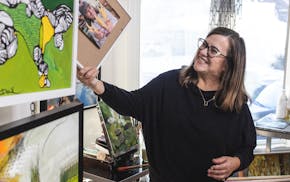Dave Kiser welcomed the mayor of Osseo at the entrance of the CCX Media cable TV station for their regular televised catch-up. The mayor, Duane Poppe, knew exactly what to do: He miked himself with a lavalier and quickly settled into a familiar armchair in a spacious professional studio for his latest recording of "Mayor's Minutes."
Before the cameras started rolling, Kiser, a fixture of the station since the 1980s, reminded the mayor of what was on their agenda. Then they launched into the chat: Emerald ash borer, the Tater Daze parade, a new police officer and the town's upcoming 150th anniversary celebrations. All in three minutes.
Such banter has been the bread and butter of community cable TV stations that provide hyperlocal news and information to the communities they serve. But now their existence is under threat, and stations are fighting to tell their story after decades of telling the stories of others.
The main source of their financial woes is a trend in which you may have partaken (well, at least your grown children have): cord-cutting. As more people cancel their cable television service and pivot to on-demand streaming, the primary source for funding community television has dried up. Stations across Minnesota have reported anywhere from 13% to 43% revenue losses over the past eight years.
CCX, for one, has seen its revenue drop from $5.7 million in 2017 to a projected $3.2 million in 2025. The Brooklyn Park-based station, which serves nine northwest metro suburbs, will likely need to lay off people and pull back on coverage if they can't slow the leaks.
OK, I get it. This is a column about community-access TV, so go ahead and ask that question about a tree falling in a forest. Would you notice if your hometown parade or local planning and zoning meeting weren't recorded? Maybe not. But you might start to care if you couldn't stream your kid's big high school game. Or if nobody was paying attention to the housing development slated for your neighborhood. Or if you're trying to decide which city council candidate to vote for, and the League of Women Voters forum in your community wasn't televised.
People crave information when an issue directly affects them.
"They don't cover our stories," said Kiser, referring to larger news organizations. "So we need somebody to do that. That's why we exist."
The need for government transparency is even more acute in greater Minnesota, where many local newspapers have shrunk or folded altogether. In Grand Rapids, about three hours north of the Twin Cities, Itasca Community Television provides gavel-to-gavel coverage of local government and school board meetings.
Even a local newspaper reporter saddled with covering various communities in the region will typically write a story about the latest school board meeting after streaming it on ICTV, said Beth George, the station's executive director.
"We're the only ones there," George told me. "Like any community, there are Facebook and Twitter accounts that are horrendous and hateful. They're alleging this and alleging that. Once in a while, someone says, 'You know what? Watch it on ICTV, and see what was actually said.'"
What's happening with community TV stations is part of a tsunami that's annihilating local news. I was reminded of my profession's increasing irrelevance to young people when a University of Minnesota student recently cold-called to hit me up for a donation to the school. While updating my contact information, he confirmed that I worked for the Minnesota Star Tribune. "Correct me if I'm wrong, but that's a newspaper, right?" he asked, with genuine curiosity.
The word "newspaper" fell off his lips like it was a concept he'd only read about in textbooks, much like the cotton gin.
The 20-year-old explained to me that he doesn't consume mainstream news but relies on social media to stay informed. The personality-driven culture of TikTok elevates the influencer who can explain their take on the world without ever having to credit the lowly paid reporter who did the actual work. Much of daily journalism is decidedly unsexy: monitoring public meetings, filing data requests, showing up in the community and crunching spreadsheets to tell the bigger story.
Community TV stations have banded across Minnesota to explain what's at stake as they push for more stable funding. Sometimes that means explaining to legislators that no, they don't receive state money. They are not TPT or MPR. Programming is primarily funded through fees that were negotiated by cities with the cable TV providers. That was the agreement struck in the 1980s: Sure, we'll let you dig up public land to build out your cable lines, but you're going to help our community stay informed.
"Should a private company have to pay for being in the public right-of-way?" asked CCX's executive director, Shannon Slatton Schwartz. "We believe yes. There should be a public benefit. If we didn't do the city council meetings, that's something that the cities would have to decide: whether or not that's a service that they want to provide their residents."
Stations are now asking lawmakers to pass a bill that would give cities the option of collecting franchise fees from broadband companies, just as they've done with cable TV. That money could be steered back to community TV outlets, which are increasingly devoting resources to their digital and social media platforms. The outlets are also seeking more than $7 million in stopgap funding.
CCX employs 25 full-time staffers, many of them with journalism degrees and TV news experience in other markets. (The average reporter makes $65,000 a year.) It's not uncommon to hear they've worked at the station for 10, 20 or 30 years. In an industry notorious for burnout, reporters here aren't expected to hop to crime scenes that unfold overnight. But they have planted deep roots in the community.
Sports director John Jacobson, who is celebrating his 35th year at CCX, reports on teen athletes whose own parents were interviewed by him back when they were in high school.
When he announces the live play-by-play, he recognizes that not all games are going to be riveting. "But it's important to the athletes who are playing that night," he said. "I try to bring that to every telecast. I don't want to make it sound like it's the most important thing ever, or that these athletes are gods, but it's important to our community, and it would be a shame if that goes away."
The vast majority of Americans have never spoken with a journalist, according to Pew Research. And trust of media is at record lows. I wish more Minnesotans could get to know people like Jacobson. Or people like Kiser, a Mr. Rogers-like personality who isn't faking enthusiasm when he talks about his love for civic suburban history.
Slatton Schwartz got emotional when she recalled the last story she filed as a reporter. It was about a Maple Grove man who volunteered at a local elementary school in honor of his late wife, who worked there. The piece won a regional Emmy, beating out entries from much bigger stations like KARE 11. It was not a story that would have garnered media attention if not for the relationships Slatton Schwartz built in the community.
As smaller newspapers die out, she notes that there are fewer places to publish obituaries, or to brag about your kid when he makes Eagle Scout.
"I believe so much in local reporting and local journalism," she said. "We've been funded well for a long time, but that's changing. We're just trying to figure it out because we know we mean a lot to the communities that we cover."

Yuen: When cancer struck a second time, she found 'euphoria'

Yuen: The University of Minnesota's first male dance team member is turning heads by staying real
Yuen: How George Floyd's aunt healed her heart and lent her voice for justice

'This is an uprising': An oral history of the 6 days after George Floyd's murder


